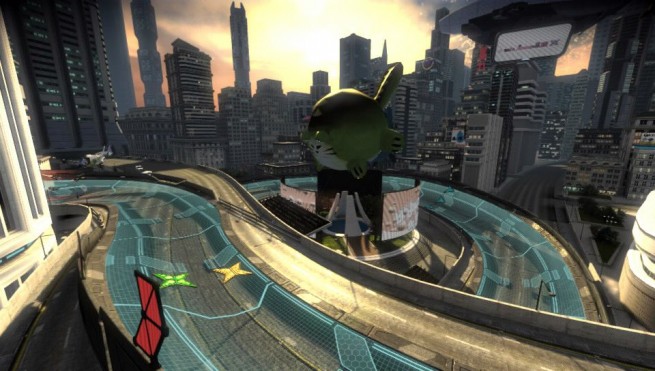As a prequel to all previous entries in Sony’s long-running anti-gravity racing series, Wipeout 2048 immediately piques your interest with its opening cinematic. The short intro visually dissects the evolution of racing from classic open-wheel roadsters to futuristic hovercrafts. Unfortunately, that’s roughly where the innovation stops, as Wipeout 2048 is virtually identical to its predecessors in all the ways that matter.
The developers do not explore the birth of the Anti-Gravity Racing Championships a single step further; instead, Wipeout 2048 succumbs to the Phantom Menace aberration where technology in the prequel is somehow just as good — if not better — as what’s seen much later in the timeline (i.e., Wipeout Pulse, which takes place in the year 2207).
The setting is a missed opportunity, though the gameplay remains top-notch. Studio Liverpool nearly perfected the Wipeout formula somewhere between the PlayStation Portable versions and Wipeout HD for the PlayStation 3, so it doesn’t seem entirely motivated to venture out of its comfort zone. This is fine, as the fast-paced racing and combat are still expertly executed and enjoyable, but how many more entries can players withstand before things become stale? I certainly hope Sony doesn’t intend to find out.
Campaign
The offline campaign is spread out over three race seasons (2048-2050), though that doesn’t really mean anything since it’s all just a bunch of event tabs in a single touchscreen hub. You’ll partake in a handful of different event types, including Races, Combat, Time Trials, Speed Laps, and Zone Events.
You can either Pass an event by meeting the easier minimum requirements, or you can Elite Pass it, usually by coming in first place. I found Elite Passes surprisingly easy to obtain on a first try, though there are a few that gave me some trouble. As you progress through the seasons and earn passes, you’ll gain experience points and level up, unlocking new ships and secret events.
Ships come in three different classes: Speed, Agility, and Fighter. Speed ships can outrun any other type of ship but at the sacrifice of shields and weapon power. Agility ships fall somewhere in the middle, providing excellent maneuverability without excelling in speed or firepower. Fighter ships may be slower and clunkier, but they can take more damage and open up new weapon types. For example, if a Speed class ship picks up a Rocket weapon, it will only fire one explosive. If a Fighter ship picks up a Rocket, however, it will fire three rockets simultaneously. You can discover and earn prototype ships as well (five prototype challenges unlock every 10 player levels). These ships have unique attributes such as starting with a lower max speed that increases each time you hit a Speed Pad during a race. The class system is a nice way to diversify the usual roster of team-based vehicles, especially with the addition of variable weapons and prototypes.
Technically, Wipeout 2048 conforms to the familiar-but-high standard set by previous titles. The visuals are crisp, though the courses would benefit from some slightly braver level design. I feel like I’ve been racing on the same freaking tracks for years (and in some cases, I have been). Each event does suffer from some pretty hefty loading times though, a reoccurring theme with Vita launch titles.
The music selection has your usual lineup of licensed electronica. It’s not a bad set at all, but it’s no Wipeout XL either. Still, when an instrumental version of The Prodigy’s Invaders Must Die peaks just as you’re flying into a shootout in a Combat Event, it’s hard not to get amped up by the soundtrack.
Zone
Yes, Zone Events get their own section in this review! First introduced in Wipeout Fusion, the unique mode really shined in Wipeout HD’s 1080p format. Zone Events simplify the gameplay down to one objective: survive. Your hovercraft accelerates automatically, so all you need to do is steer. The longer you survive, the faster your ship gets. Hitting walls shaves points off your health, and eventually you’ll be screaming along so quickly that one wrong move can pinball you into obliteration.
While the dynamic gameplay keeps Zone mode exponentially exciting, the psychedelic visuals play an even bigger role in the experience. Environments have been stripped of textures, instead replaced with vivid monochromatic colors. Wipeout 2048’s Zone seems to be the most aesthetically brilliant yet, truly taking advantage of the Vita’s OLED display. With techno music pounding away and the track’s color scheme reinventing itself each time the speed class is increased, Zone is a lot like what I imagine Lumines would be like if it had a F5000 anti-gravity engine strapped to it.


